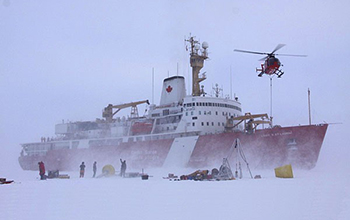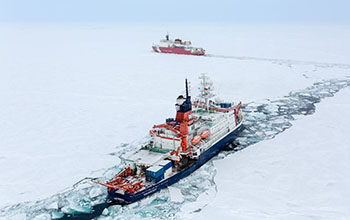搜索结果: 1-15 共查到“理学 the Arctic Ocean”相关记录33条 . 查询时间(0.062 秒)
Last ice-covered parts of summertime Arctic Ocean vulnerable to climate change
climate change summertime ice-covered part
2021/8/4
Last August, sea ice north of Greenland showed its vulnerability to the long-term effects of climate change. The region, part of what's known as the 'Last Ice Area' that could serve as a refuge for ic...

Carbon dioxide levels are rising across wide swaths of the Arctic Ocean's Canada Basin(图)
Carbon dioxide levels rising across wide swaths Arctic Ocean Canada Basin
2020/7/10
Melting of Arctic ice caused by climate change has exposed more sea surface to the atmosphere. Scientists have long suspected this trend would increase carbon dioxide in Arctic Ocean waters.Now U...

Carbon dioxide levels are rising across wide swaths of the Arctic Ocean's Canada Basin(图)
Carbon dioxide levels rising across wide swaths Arctic Ocean Canada Basin
2020/7/3
Melting of Arctic ice caused by climate change has exposed more sea surface to the atmosphere. Scientists have long suspected this trend would increase carbon dioxide in Arctic Ocean waters.Now U...

Freshwater runoff from rivers brings more carbon, nutrients to Arctic Ocean(图)
Freshwater runoff rivers carbon nutrients Arctic Ocean
2020/4/17
A new study by National Science Foundation-funded researchers at the Woods Hole Oceanographic Institution and their colleagues found that freshwater runoff from rivers and continental s...
International team reports ocean acidification spreading rapidly in Arctic Ocean
International team reports ocean acidification spreading rapidly Arctic Ocean
2017/3/14
Ocean acidification (OA) is spreading rapidly in the western Arctic Ocean in both area and depth, according to new interdisciplinary research reported in Nature Climate Change by a team of internation...
HAUSGARTEN: Multidisciplinary Investigations at a Deep-Sea, Long-Term Observatory in the Arctic Ocean
Multidisciplinary Investigations Deep-Sea
2015/7/30
The marine Arctic has played an essential role in the history of our planet over the past 130 million years and contributes considerably to the present functioning of Earth and its life. The global cy...
The Arctic Coring Expedition (ACEX) Recovers a Cenozoic History of the Arctic Ocean
Arctic Coring Expedition (ACEX) Recovers a Cenozoic History Arctic Ocean
2015/7/24
The Arctic Ocean is a small, nearly landlocked ocean basin that is the shallowest in the world (Figure 1). It has maintained a polar location since forming in Early Cretaceous times (Grantz et al., 19...
Hovercraft as a Mobile Science Platform Over Sea Ice in the Arctic Ocean
Arctic Ocean Science Platform Over Sea Ice
2015/7/17
Physical sampling of sea ice, the water mass, and subbottom geology in the Arctic Ocean is carried out from icebreakers or temporary ice camps deployed and supported by aircraft. Here, we consider an ...
Light and nutrient control of photosynthesis in natural phytoplankton populations from the Chukchi and Beaufort seas, Arctic Ocean
Light nutrient control of photosynthesis
2014/4/2
During the 2010–2011 ‘Impacts of Climate Change on the EcoSystems and Chemistry of the Arctic Pacific
Environment’ project, we measured photosynthetic parameters in natural Arctic phytoplankton assem...
A substantial export flux of particulate organic carbon linked to sinking dead copepods during winter 2007–2008 in the Amundsen Gulf (southeastern Beaufort Sea, Arctic Ocean)
A substantial export flux particulate organic carbon linked sinking dead copepods during 2007–2008 the Amundsen Gulf (southeastern Beaufort Sea, Arctic Ocean)
2014/4/2
In the Arctic Ocean, vertical fluxes of particulate organic carbon (POC) remain low during the dark winter period because POC fluxes are derived from photosynthetic production. Passively sinking dead ...
Bromine measurements in ozone depleted air over the Arctic Ocean
Bromine measurements ozone depleted air the Arctic Ocean
2010/8/16
In situ measurements of ozone, photochemically active bromine compounds, and other trace gases over the Arctic Ocean in April 2008 are used to examine the chemistry and geographical extent of ozone de...
Quantifying the clear-sky temperature inversion frequency and strength over the Arctic Ocean during summer and winter seasons from AIRS profiles
the clear-sky temperature inversion frequency and strength the Arctic Ocean summer and winter seasons AIRS profiles
2010/8/13
Temperature inversions are one of the dominant features of the Arctic atmosphere and play a crucial role in various processes by controlling the transfer of mass and moisture fluxes through the lower ...
Circumpolar measurements of speciated mercury, ozone and carbon monoxide in the boundary layer of the Arctic Ocean
Circumpolar measurements speciated mercury ozone and carbon monoxide the boundary layer the Arctic Ocean
2010/8/13
Using the Swedish icebreaker Oden as a platform, continuous measurements of airborne mercury (gaseous elemental mercury (Hg0), divalent gaseous mercury species HgIIX2(g) (acronym RGM) and mercury atta...
Climatic transitions in the Arctic as revealed by mineralogical evidence from the Upper Cenozoic sediments in the central Arctic Ocean and the Yermak Plateau
Climatic transitions mineralogical evidence Upper Cenozoic sediments central Arctic Ocean
2009/12/2
Mineralogical characteristics of the sediments can be used to evaluate critical climate transitions in the Arctic Ocean based on a close relationship between ice-sheet initiation, ice rafting and sea-...
Extensive local seabed disturbance,erosion and mass wasting on Alpha Ridge,Central Arctic Ocean:possible evidence for an extra-terrestrial impact?
local seabed disturbance Central Arctic Ocean possible evidence extra-terrestrial impact
2009/12/2
Sub-bottom sediments within a 200 x 600 km area on the crest and south slope (water depth 1200-2500 meter) of the submarine Alpha Ridge in the central Arctic Ocean have been locally disrupted down to ...

